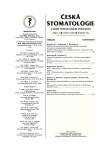Stability of Bone Bed Crest of Loaded Implant – Comparison with Finite Element Models
Stabilita okraje kostního lůžka zatěžovaného implantátu – porovnání s matematickými modely
Adaptace kostního lůžka implantátu na působící zatížení se v RTG obrazu většinou projevuje jako miskovitá resorpce kosti v okolí krčku implantátu. V prvním roce po zatížení dochází k výraznějšímu úbytku okraje kosti, poté se stav buď stabilizuje nebo resorpce okraje kosti pokračuje až dojde ke ztrátě implantátu. Studie je zaměřena na porovnávání stability okraje kostního lůžka implantátů v závislosti na tvaru, velikosti a sklonu nitrokostní části implantátu a na druhu nesené protetické práce. U sledovaných implantátů byly každých šest měsíců zhotoveny RVG snímky. Z nich byl sestaven profil implantátu a určena jeho stabilita. Počty stabilních a nestabilních implantátů vzhledem k velikosti, tvaru a sklonu nitrokostní části implantátu i k nesené protetické práci byly statisticky zpracovány a porovnány s matematickými modely. Rozdíly mezi jednotlivými způsoby zatížení nejsou signifikantní, s výjimkou implantátu použitého jako vmezeřený pilíř mezi vlastní zuby pacienta. Korelace s matematickými modely není výrazná zejména proto, že pohyby a síly působící při funkci nejsou přesně známé a popsané, a do modelů byly zadány průměrné hodnoty. Pro potřeby klinické praxe je nezbytné matematické modely individualizovat.
Klíčová slova:
dentální implantáty – velikost – tvar – sklon – RVG – protetické práce – matematické modely – metoda konečných prvků
Authors:
L. Himmlová 1; T. Goldmann 2; A. Kácovský 2
Authors‘ workplace:
Výzkumný ústav stomatologický 1. LF UK a VFN, Praha
přednostka prof. MUDr. J. Dušková, DrSc.
1; ČVUT Praha, Fakulta strojní, Ústav mechaniky, Praha
vedoucí ústavu prof. Ing. S. Konvičková, CSc.
2
Published in:
Česká stomatologie / Praktické zubní lékařství, ročník 105, 2005, 3, s. 66-72
Overview
The adaptation of the implant bone bed to chewing force has been quite often represented in X-ray images as the bowl shaped resorption around the implant neck. During the first year after the implant loading the marginal bone loss around the neck is more pronounced. Subsequeutly, the rate of the bone loss is either arrested or the resorption of the bone crest continues and the implant is lost within a few years. This study compared stability of the bone bed crest of the loaded implant to the size, shape and inclination of enosseal part of the implant and to the anchored denture. All the implants monitored in the study were scanned by X-ray images every 6 months. The bone profile and stability characteristics for each implant were assembled. Numbers of stable and non-stable implants with respect to their size, shape and inclination of the enosseal part of the implant and to anchored denture were statistically evaluated and compared to mathematical finite element models. Differences among various types of loading, represented by different types of dentures were not significant, excluding a group of fixed bridges, where an implant was used as interpositioned pillar between natural teeth. Correlation between findings in vivo and mathematical models is not distinct. This is probably because movements of mandible and chewing forces are individual and they have not been studied thoroughly yet. Moreover, in models ordinary values were used, whereas in clinical practice it is necessary to use individual values.
Key words:
dental implants – size, shape and inclincation of enosseal part – radiovisiography – dentures – stress distribution – finite element method
Labels
Maxillofacial surgery Orthodontics Dental medicineArticle was published in
Czech Dental Journal

2005 Issue 3
- What Effect Can Be Expected from Limosilactobacillus reuteri in Mucositis and Peri-Implantitis?
- The Importance of Limosilactobacillus reuteri in Administration to Diabetics with Gingivitis
Most read in this issue
- Focal Infection of Dental Origin – (Review article)
- Prevalence of Apical Periodontitis and Frequency of Root-Filled Teeth in an Adult Czech Population
- Immediate Implants and Their Use in Clinical Stomatological Practice
- Verification of Validity of Caries Measuring by Laser Fluorescent Apparatus KaVo DIAGNOdent
